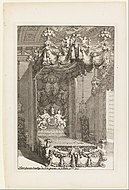Daniel Marot
Daniel Marot (* 1661 in Paris ; † June 4, 1752 in The Hague ) was a French Protestant, architect and engraver of the neoclassical late baroque style in the style of Louis XIV . He was the son of Jean Marot (1620–1679), who had also been an architect and engraver and who depicted the buildings of Louis XIV in his engravings .
Life
He was born in Paris to a Huguenot family who left France to settle in the Netherlands in 1685, the year of the Edict of Fontainebleau and the repeal of the Edict of Nantes . He became a student of Jean Le Pautre and worked as a freelance copperplate engraver from a young age.
In the Netherlands, Marot found employment with the Dutch governor and later King Wilhelm III of England . He designed the large audience hall for the States General in The Hague and also decorated numerous Dutch country houses.
In 1694 he traveled to London with King William, where he was appointed one of its architects. In England, its activities appear to have centered on Hampton Court Palace . Much of the furniture, especially the mirrors and state beds in the new state rooms, bear the marks of his hand. He designed practically every detail of the decoration of the house - carved mantelpiece, stucco ceilings, wall coverings, chandeliers and even side tables, gold and silver dishes and containers for porcelain.
After the king's death in 1702, he returned to Holland, where he stayed for the rest of his life.
plant
Marot was involved in buildings such as the Het Loo Palace near Apeldoorn , Oranienstein Palace or the Schuylenburch Palace, as well as the expansion of the Old Town Hall in The Hague .
Binnenhof , The Hague
Engraving by MarotHampton Court (1708) with garden ground floor by Marot
Grave monument for Menno van Coehoorn († 1704)
Grave monument for Philip of Hessen-Philippsthal († 1721)
Web links
- Literature by and about Daniel Marot in the catalog of the German National Library
| personal data | |
|---|---|
| SURNAME | Marot, Daniel |
| BRIEF DESCRIPTION | French architect and engraver |
| DATE OF BIRTH | 1661 |
| PLACE OF BIRTH | Paris |
| DATE OF DEATH | June 4, 1752 |
| Place of death | The hague |








